3.3 m9u1 教案
- 格式:doc
- 大小:60.00 KB
- 文档页数:10
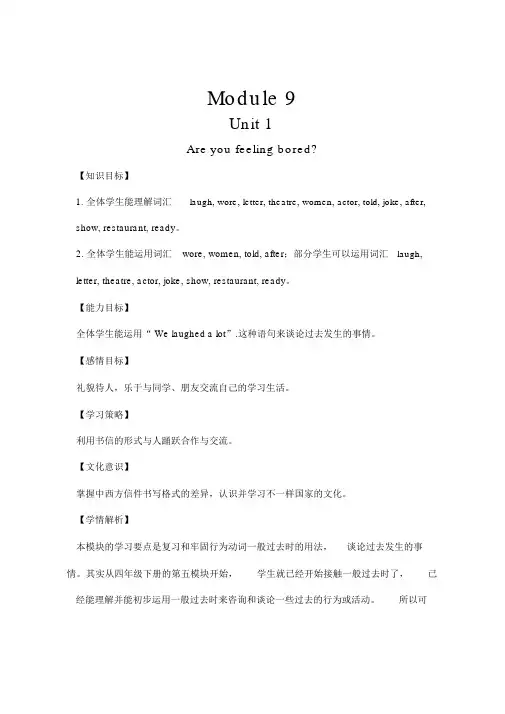
Module 9Unit 1Are you feeling bored?【知识目标】1. 全体学生能理解词汇laugh, wore, letter, theatre, women, actor, told, joke, after, show, restaurant, ready。
2. 全体学生能运用词汇wore, women, told, after;部分学生可以运用词汇laugh, letter, theatre, actor, joke, show, restaurant, ready。
【能力目标】全体学生能运用“ We laughed a lot”.这种语句来谈论过去发生的事情。
【感情目标】礼貌待人,乐于与同学、朋友交流自己的学习生活。
【学习策略】利用书信的形式与人踊跃合作与交流。
【文化意识】掌握中西方信件书写格式的差异,认识并学习不一样国家的文化。
【学情解析】本模块的学习要点是复习和牢固行为动词一般过去时的用法,谈论过去发生的事情。
其实从四年级下册的第五模块开始,学生就已经开始接触一般过去时了,已经能理解并能初步运用一般过去时来咨询和谈论一些过去的行为或活动。
所以可以经过活动和游戏的设计帮助基础较单薄的学生牢固、增强行为动词一般过去式的用法。
【教课重难点】要点:复习和牢固行为动词一般过去时的用法,谈论过去发生的事情。
难点:能正确书写一般过去时的语句,熟练掌握不规则动词形式的变化。
【课前准备】1.单词卡片 /时间显现图;2.教课光盘或其余录音机设备;3.教课课件。
【教课过程】Step 1:Warm up and lead in1. English show before class【设计企图】供给学生显现自我的平台,提升学生的口语水平易使用英语的能力,增强团队意识,体验成功的乐趣。
2. Greetings.3. Sing a song: What did you do?Step 2:Task PresentationShow the task of this lesson (PPT 出示)’ ll talk about what you di T: This lesson we ’ ll review the past tense. After learning welast week to your partner.Step 3:Text Learning1. Look at a picture of Daming in M9 U1 and answer the question. (PPT)What is Daming doing?Who wrote this letter to Daming ?T: How do you know the answer? (PPT)One more question: Where was this letter from? (PPT)2.Talk about the differences between Chinese letter and English letter.3.Read the letter and answer the questions, then talk about in groups. Where did they go?What did they see ?What did they eat ? (PPT 出示)【设计企图】学生自主阅读、小组合作交流,谈论解决阅读中的问题,培育学生小组合作意识,达到“兵帮兵,兵强兵”的目的。
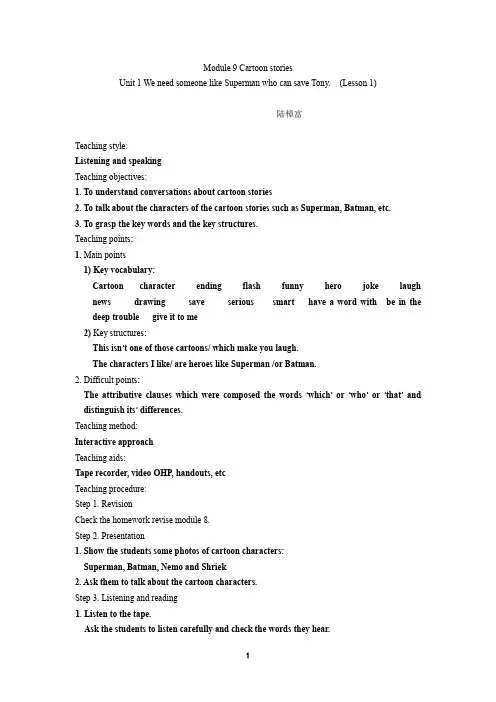
Module 9 Cartoon storiesUnit 1 We need someone like Superman who can save Tony. (Lesson 1)陆樟富Teaching style:Listening and speakingTeaching objectives:1. To understand conversations about cartoon stories2. To talk about the characters of the cartoon stories such as Superman, Batman, etc.3. To grasp the key words and the key structures.Teaching points:1. Main points1) Key vocabulary:Cartoon character ending flash funny hero joke laugh news drawing save serious smart have a word with be in the deep trouble give it to me2) Key structures:This isn’t one of those cartoons/ which make you laugh.The characters I like/ are heroes like Superman /or Batman.2. Difficult points:The attributive clauses which were composed the words ‘which’or ‘who’or ‘that’and distinguish its’ differences.Teaching method:Interactive approachTeaching aids:Tape recorder, video OHP, handouts, etcTeaching procedure:Step 1. RevisionCheck the homework revise module 8.Step 2. Presentation1. Show the students some photos of cartoon characters:Superman, Batman, Nemo and Shriek2. Ask them to talk about the cartoon characters.Step 3. Listening and reading1. Listen to the tape.Ask the students to listen carefully and check the words they hear.2. Play the tape once more and let the students to answer the questions in activitythen check their answers.3. Play the tape again. Make students read and follow.4. Read the summary of the conversation and underline the wrong information.Listen again and correct the summary.Step 4. Answer the questions1.Ask the students to complete the answers individually, and then check with a partner.2.Call back the answers from the whole class, having one student ask and another answerit.Step 5. Read through the words with the whole class. Work in pairs. Ask and answer the questions. They can check in groups. At last, teacher has a check.Step 6.Homework.1.Read the passage.2.Finish the exercises.感谢您的阅读,祝您生活愉快。
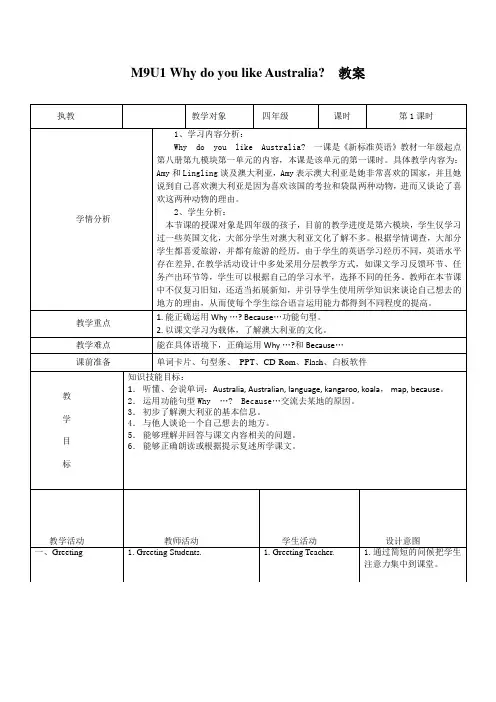
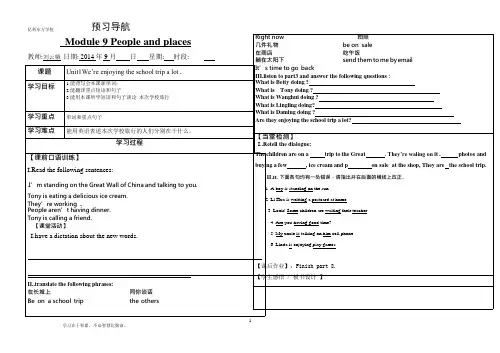
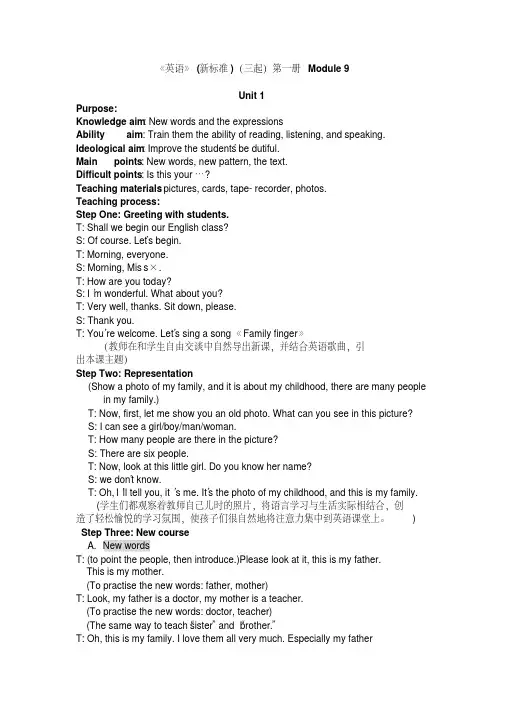
《英语》(新标准)(三起)第一册Module 9Unit 1Purpose:Knowledge aim: New words and the expressionsAbility aim: Train them the ability of reading, listening, and speaking. Ideological aim: Improve the students’ be dutiful.Main points: New words, new pattern, the text.Difficult points: Is this your…?Teaching materials: pictures, cards, tape- recorder, photos.Teaching process:Step One: Greeting with students.T: Shall we begin our English class?S: Of course. Let’s begin.T: Morning, everyone.S: Morning, Mis s×.T: How are you today?S: I’m wonderful. What about you?T: Very well, thanks. Sit down, please.S: Thank you.T: You’re welcome. Let’s sing a song 《Family finger》(教师在和学生自由交谈中自然导出新课,并结合英语歌曲,引出本课主题)Step Two: Representation(Show a photo of my family, and it is about my childhood, there are many people in my family.)T: Now, first, let me show you an old photo. What can you see in this picture?S: I can see a girl/boy/man/woman.T: How many people are there in the picture?S: There are six people.T: Now, look at this little girl. Do you know her name?S: we don’t know.T: Oh, I’ll tell you, it’s me. It’s the photo of my childhood, and this is my family.(学生们都观察着教师自己儿时的照片,将语言学习与生活实际相结合,创造了轻松愉悦的学习氛围,使孩子们很自然地将注意力集中到英语课堂上。
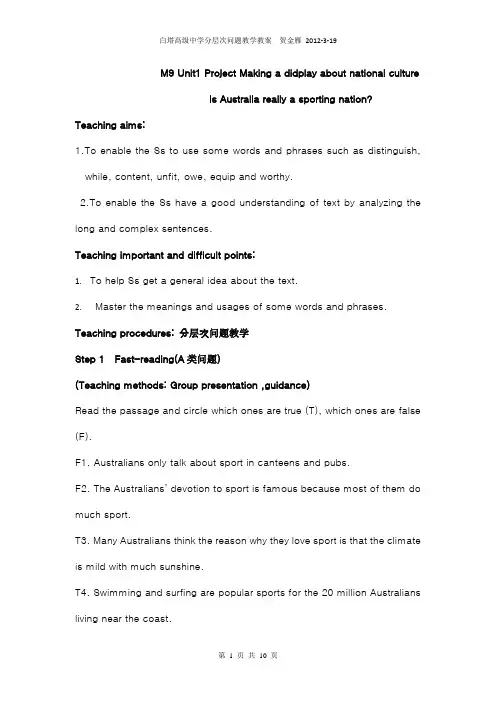
M9 Unit1 Project Making a didplay about national cultureIs Australia really a sporting nation?Teaching aims:1.To enable the Ss to use some words and phrases such as distinguish, while, content, unfit, owe, equip and worthy.2.To enable the Ss have a good understanding of text by analyzing the long and complex sentences.Teaching important and difficult points:1.To help Ss get a general idea about the text.2.Master the meanings and usages of some words and phrases. Teaching procedures: 分层次问题教学Step 1 Fast-reading(A类问题)(Teaching methods: Group presentation ,guidance)Read the passage and circle which ones are true (T), which ones are false (F).F1. Australians only talk about sport in canteens and pubs.F2. The Australians’ dev otion to sport is famous because most of them do much sport.T3. Many Australians think the reason why they love sport is that the climate is mild with much sunshine.T4. Swimming and surfing are popular sports for the 20 million Australians living near the coast.F5. Many Australians often play tennis in the evening or late into the night because they can see well due to the lighting facilities.F6. While playing footy, players cannot hold the ball. They can only run after it.F7. Cricket was born in Australia and has been exported to the UK and many other countries.T8. For most Australians, horse racing is a sport to watch rather than to participate.T9. The achievements that Australians have achieved at different international games prove that Australia is really a sporting nation.Step 2 Careful-reading(Teaching methods: Group presentation ,guidance and interaction)Read the passage carefully and fill in the blanks .Answers:1 Reasons 2 Mild 3. including 4. encouragement 5. Popular 6. surfing 7. team 8. achievements 9 ranking 10. ConclusionStep3 Language study(B类问题)(Teaching methods: Group presentation ,guidance and interaction)1. The sport that most of the world calls football is known as soccer in Australia, to dis tinguish it from ‘footy’, which is short for Australian rules football.(P14Line28—30)distinguish (v.) 区分,区别;使与众不同eg. The girl is color-blind; she can’t distinguish between colors.这女孩是色盲,她不能辨别颜色。
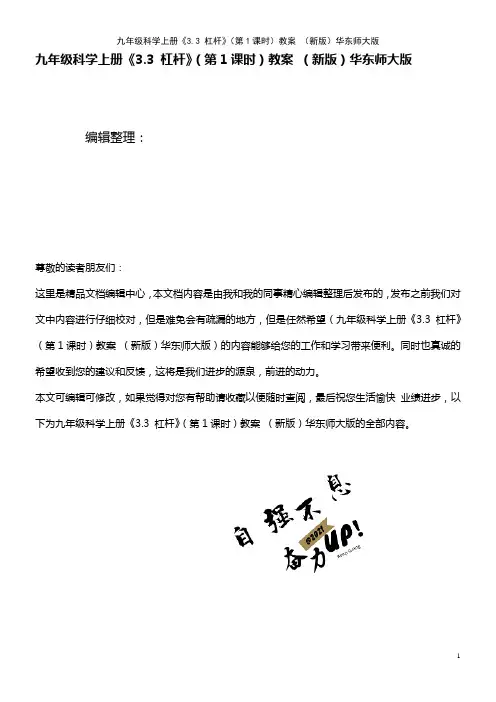
九年级科学上册《3.3 杠杆》(第1课时)教案(新版)华东师大版编辑整理:尊敬的读者朋友们:这里是精品文档编辑中心,本文档内容是由我和我的同事精心编辑整理后发布的,发布之前我们对文中内容进行仔细校对,但是难免会有疏漏的地方,但是任然希望(九年级科学上册《3.3 杠杆》(第1课时)教案(新版)华东师大版)的内容能够给您的工作和学习带来便利。
同时也真诚的希望收到您的建议和反馈,这将是我们进步的源泉,前进的动力。
本文可编辑可修改,如果觉得对您有帮助请收藏以便随时查阅,最后祝您生活愉快业绩进步,以下为九年级科学上册《3.3 杠杆》(第1课时)教案(新版)华东师大版的全部内容。
第三节杠杆教学目标:知识和技能:1、认识生活和生产中的各种杠杆,了解人体杠杆。
2、认识杠杆的支点、动力、阻力、动力臂和阻力臂.3、知道杠杆的一些应用及分类、。
过程与方法:1.通过观察与体验,了解杠杆的结构.2.通过体验和探究,了解杠杆的平衡条件。
情感、态度与价值观:1、通过了解杠杆的应用,进一步认识科学与生活密切联系,科学源于生活,提高关注生活、学习科学的兴趣。
2、通过了解古代杠杆,使学生初步树立劳动人民创造科学史的意识。
教学重点:理解杠杆的五要素、杠杆的平衡条件及计算公式。
教学难点:理解力臂的概念及其画法。
教学准备:两课时课件,每生一张印有配套课堂作业的练习纸;学生带罐头起子、啤酒开、剪刀、钢丝钳、扳手、筷子、道钉撬、杆秤、钉书机、罐头、直尺等;小组准备:杠杆(含铁架台)、钩码、棉线等第一课时教学过程一、导入新课课前播放“阿基米德之给我一根……"动画以引入新课。
二、新授师:同学们,你们桌上都放着一个食品罐头,假设里面放着你特喜欢的水果,请你快点打开盖子吧.不过打开前请看完“活动一”中的要求.投影“活动一”图片。
学生打开盖子交流感受。
师:现在请同学们试着使用自带的其它工具(预先布置学生分组带啤酒开、剪刀、钉书机、钢丝钳、扳手等),体验一下,然后说出它们有什么共同点?学生互相补充说明。
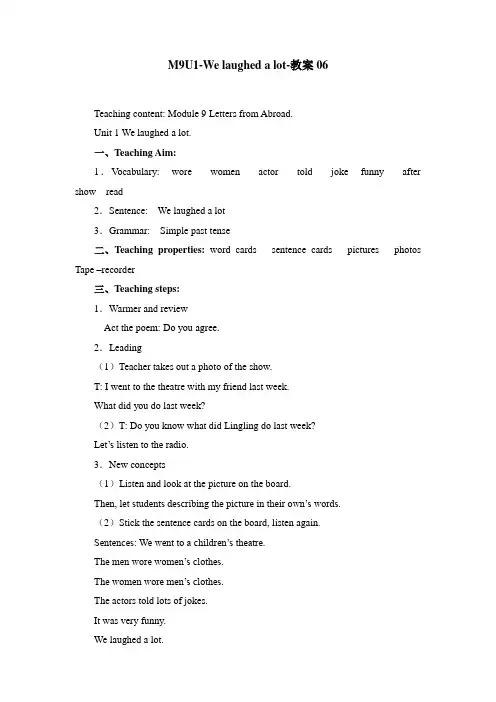
M9U1-We laughed a lot-教案06Teaching content: Module 9 Letters from Abroad.Unit 1 We laughed a lot.一、Teaching Aim:1.V ocabulary: wore women actor told joke funny after show read2.Sentence: We laughed a lot3.Grammar: Simple past tense二、Teaching properties:word cards sentence cards pictures photos Tape –recorder三、Teaching steps:1.Warmer and reviewAct the poem: Do you agree.2.Leading(1)Teacher takes out a photo of the show.T: I went to the theatre with my friend last week.What did you do last week?(2)T: Do you know what did Lingling do last week?Let’s listen to the radi o.3.New concepts(1)Listen and look at the picture on the board.Then, let students describing the picture in their own’s words.(2)Stick the sentence cards on the board, listen again.Sentences: We went to a children’s theatre.The men wore women’s clothes.The women wore men’s clothes.The actors told lots of jokes.It was very funny.We laughed a lot.We went to a restaurant after the show.We all ate hamburgers and chips.Then, let students describing, use the sentence cards.(3)Teacher circles the words: went wore told was laughed ate Then, give the words: go wear tell is laugh eatLet the students match then.(4)Read sentences on the cardsLet students recollect what did Lingling do last week.(5)Listen and repeat the text.(6)Answer the questions on your paper.A.Where did Lingling go last week?B.What did the men and the women wear?C.What did the actors do?D.Where did they go after the show?E.Wheat did they eat?4.PracticeStudents take out their own pictures to describing what did they do .5.Do Activity Book.(1)Exercise 1 Listen and complete the text.(2)Exercise 4 Read and circle the correct words.6.HomeworkTalk about what you did yesterday.Designs: Module 9 Letters from AboardUnit 1 We laughed a lotwent laughwere eattold iswas golaughed areate tell。
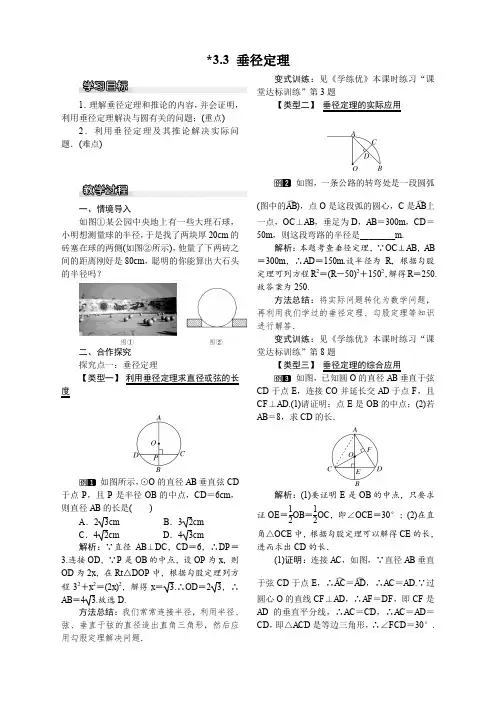
*3.3 垂径定理1.理解垂径定理和推论的内容,并会证明,利用垂径定理解决与圆有关的问题;(重点)2.利用垂径定理及其推论解决实际问题.(难点)一、情境导入 如图①某公园中央地上有一些大理石球,小明想测量球的半径,于是找了两块厚20cm 的砖塞在球的两侧(如图②所示),他量了下两砖之间的距离刚好是80cm ,聪明的你能算出大石头的半径吗?二、合作探究 探究点一:垂径定理 【类型一】 利用垂径定理求直径或弦的长度如图所示,⊙O 的直径AB 垂直弦CD于点P ,且P 是半径OB 的中点,CD =6cm ,则直径AB 的长是( )A .23cmB .32cmC .42cmD .43cm解析:∵直径AB ⊥DC ,CD =6,∴DP =3.连接OD ,∵P 是OB 的中点,设OP 为x ,则OD 为2x ,在Rt △DOP 中,根据勾股定理列方程32+x 2=(2x )2,解得x = 3.∴OD =23,∴AB =4 3.故选D.方法总结:我们常常连接半径,利用半径、弦、垂直于弦的直径造出直角三角形,然后应用勾股定理解决问题.变式训练:见《学练优》本课时练习“课堂达标训练”第3题【类型二】 垂径定理的实际应用如图,一条公路的转弯处是一段圆弧(图中的AB ︵),点O 是这段弧的圆心,C 是AB ︵上一点,OC ⊥AB ,垂足为D ,AB =300m ,CD =50m ,则这段弯路的半径是________m.解析:本题考查垂径定理,∵OC ⊥AB ,AB =300m ,∴AD =150m.设半径为R ,根据勾股定理可列方程R 2=(R -50)2+1502,解得R =250.故答案为250.方法总结:将实际问题转化为数学问题,再利用我们学过的垂径定理、勾股定理等知识进行解答.变式训练:见《学练优》本课时练习“课堂达标训练”第8题 【类型三】 垂径定理的综合应用如图,已知圆O 的直径AB 垂直于弦CD 于点E ,连接CO 并延长交AD 于点F ,且CF ⊥AD .(1)请证明:点E 是OB 的中点;(2)若AB =8,求CD 的长.解析:(1)要证明E 是OB 的中点,只要求证OE =12OB =12OC ,即∠OCE =30°;(2)在直角△OCE 中,根据勾股定理可以解得CE 的长,进而求出CD 的长.(1)证明:连接AC ,如图,∵直径AB 垂直于弦CD 于点E ,∴AC ︵=AD ︵,∴AC =AD .∵过圆心O 的直线CF ⊥AD ,∴AF =DF ,即CF 是AD 的垂直平分线,∴AC =CD ,∴AC =AD =CD ,即△ACD 是等边三角形,∴∠FCD =30°.在Rt △COE 中,OE =12OC ,∴OE =12OB ,∴点E 为OB 的中点;(2)解:在Rt △OCE 中,AB =8,∴OC =OB =12AB =4.又∵BE =OE ,∴OE =2,∴CE =OC 2-OE 2=16-4=23,∴CD =2CE =4 3.方法总结:解此类题一般要把半径、弦心距、弦的一半构建在一个直角三角形里,运用勾股定理求解.变式训练:见《学练优》本课时练习“课后巩固提升”第5题探究点二:垂径定理的推论【类型一】 利用垂径定理的推论求角的度数如图所示,⊙O 的弦AB 、AC 的夹角为50°,M 、N 分别是AB ︵、AC ︵的中点,则∠MON 的度数是( )A .100°B .110°C .120°D .130°解析:已知M 、N 分别是AB ︵、AC ︵的中点,由“平分弧的直径垂直平分弧所对的弦”得OM ⊥AB 、ON ⊥AC ,所以∠AEO =∠AFO =90°,而∠BAC =50°,由四边形内角和定理得∠MON =360°-∠AEO -∠AFO -∠BAC =360°-90°-90°-50°=130°.故选D.变式训练:见《学练优》本课时练习“课堂达标训练”第6题.【类型二】 利用垂径定理的推论求边的长度如图,点A 、B 是⊙O 上两点,AB =10cm ,点P 是⊙O 上的动点(与A 、B 不重合),连接AP 、BP ,过点O 分别作OE ⊥AP 于E ,OF ⊥PB 于F ,求EF 的长.解析:运用垂径定理先证出EF 是△ABP 的中位线,然后运用三角形中位线性质把要求的EF 与AB 建立关系,从而解决问题.解:在⊙O 中,∵OE ⊥AP ,OF ⊥PB ,∴AE =PE ,BF =PF ,∴EF 是△ABP 的中位线,∴EF =12AB =12×10=5(cm).方法总结:垂径定理虽是圆的知识,但也不是孤立的,它常和三角形等知识综合来解决问题,我们一定要把知识融会贯通,在解决问题时才能得心应手.变式训练:见《学练优》本课时练习“课后巩固提升”第2题【类型三】 动点问题如图,⊙O 的直径为10cm ,弦AB =8cm ,P 是弦AB 上的一个动点,求OP 的长度范围.解析:当点P 处于弦AB 的端点时,OP 最长,此时OP 为半径的长;当OP ⊥AB 时,OP 最短,利用垂径定理及勾股定理可求得此时OP 的长.解:作直径MN ⊥弦AB ,交AB 于点D ,由垂径定理,得AD =DB =12AB =4cm.又∵⊙O的直径为10cm ,连接OA ,∴OA =5cm.在Rt △AOD 中,由勾股定理,得OD =OA 2-AD 2=3cm.∵垂线段最短,半径最长,∴OP 的长度范围是3cm ≤OP ≤5cm.方法总结:解题的关键是明确OP 最长、最短时的情况,灵活利用垂径定理求解.容易出错的地方是不能确定最值时的情况.三、板书设计垂径定理1.垂径定理2.垂径定理的推论垂径定理是中学数学中的一个很重要的定理,由于它涉及的条件结论比较多,学生容易搞混淆,本节课采取了讲练结合、动手操作的教学方法,课前布置所有同学制作一张圆形纸片,课上利用此纸片探索、体验圆是轴对称图形,并进一步利用圆的轴对称性探究垂径定理,环环相扣、逐层深入,激发学生的学习兴趣,收到了很好的教学效果.。
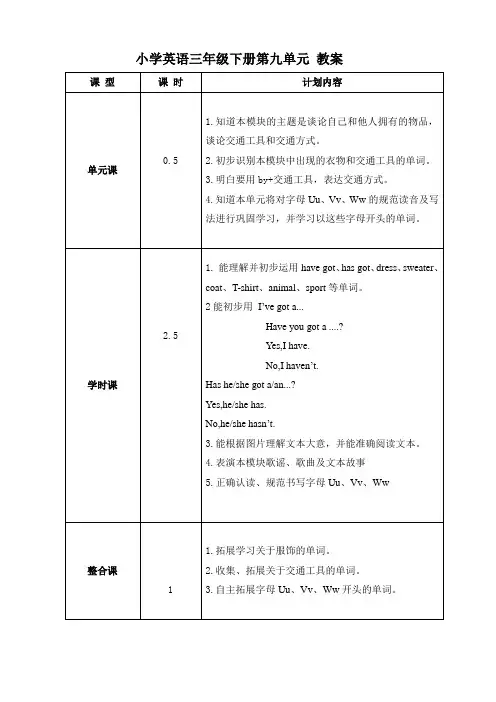
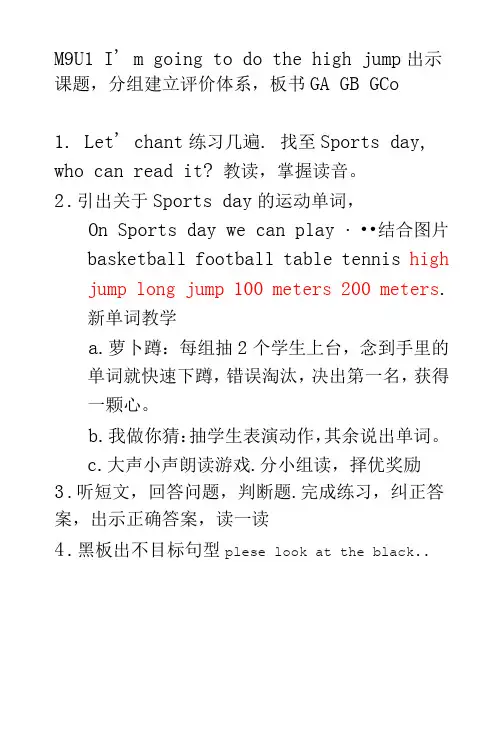
M9U1 I' m going to do the high jump出示课题,分组建立评价体系,板书GA GB GCo1. Let' chant练习几遍. 找至Sports day, who can read it? 教读,掌握读音。
2.引出关于Sports day的运动单词,On Sports day we can play ・••结合图片basketball football table tennis high jump long jump 100 meters 200 meters.新单词教学a.萝卜蹲:每组抽2个学生上台,念到手里的单词就快速下蹲,错误淘汰,决出第一名,获得一颗心。
b.我做你猜:抽学生表演动作,其余说出单词。
c.大声小声朗读游戏.分小组读,择优奖励3.听短文,回答问题,判断题.完成练习,纠正答案,出示正确答案,读一读4.黑板出不目标句型plese look at the black..What are you going to do on sports day?I' m going to,e,Who can read it?教读,纠正发音,练习9.创设情境:OK! We' re going to have a sports day tomorrow. 抽问学生:What are you going to do on sports day? 1。
讲解关键:前面加上play、do the. run the 并板书,再读一读。
11.再抽问学生,回答后让其点另一个学生回答,循环下去。
10.开火车练习问答,奖励表现好的小组。
a plan for sports day.(表格)屏幕上示范一下如何填表。
12.表格展示Liu is going to do the long jump on sports day.All of you did a good job.13.情感教育:No sports, no life!生命在于运动。
四年级上 M9U1 Are you going to run on sports day?教学设计【教材分析】本模块主要学习的语言功能是制定计划。
本单元课文情境是运动会,与同学们日常生活联系密切,学生比较感兴趣。
主要围绕Daming 打算参加100 米短跑比赛,每天早起去公园跑步展开。
使用到的功能句是Are you going to on sports day? Yes, Iam / No, I’m not。
以及用i am going to ..... 描述自己的计划打算。
【学情分析】四年级的学生比较好动,好奇,好胜与好玩,有集体荣誉感,模仿能力强,有一定的逻辑思维能力,部分学生有较强的组织能力。
在课堂上教师可通过听、说、读、问、演等活动,极大学生学习的兴趣,培养学生良好的学习习惯,逐步形成有效的学习方法,发展自主学习的能力。
本单元的其中一个功能句i am going to .... 在前一个模块中已接触过,难度不大。
而功能句Are you going to ..... on sports day?的熟练运动有一定难度【教学目标】1.语言知识与技能目标:(1)学生能在拼读卡的帮助下,听懂、认读、拼读出单词sports,month,hundred,metre;(2)学生能在思维导图和图片的提示下,说出儿童运动会常见项目。
(3)学生能在老师和情境的引导下听说,认读课文及功能句Are you going to run on sports day?Yes, I am going to .../ No,I am going to..... 并在学校马上举办运动会这一真实的语言情境中,运用功能句询问他人的计划与说明自己的计划。
2,情感目标:通过学习大明赢得冠军的过程,学生能够体会“No pains,no gains”一份耕耘,一份收获。
【教学重难点】1.教学重点:掌握及运用词汇sports,month,hundred 和句型Are you going to run on sports day?Yes, i am going to .../ No, I am going to ....2.教学难点:(1)课文长句的朗读We are going to have a sports day this month.(2)熟练运用功能句Are you going to run on sports day?询问他人的计划【教学方法】根据四年级学生的年龄特点和思维特点,使用任务教学法,交际法,小组合作法引导他们主动地投入到教学中来,创造轻松高效的英语课堂。
Teaching steps:
Step 1 : Warmer 1、Greetings: T: Ok,Let’s begin our class. Good morning, boys and girls!
Ss: Good morning, Ms Ren! T: How are you today? Ss: I’m fine, thank you. And how are you? T: I’m fine, thanks. Let’s say a chant and do some actions , ok? Ss: OK! T : Are you ready? Ss: Yes!
Make a cake, Make a cake, put it in the pan. Make a cake, Make me a cake, as fast as you can.(动作指导:边唱边拍手 ) (设计意图:师生一起边说边做动作的过程调动了学生学习英语的积极性,活跃了课堂气氛。)
Step 2. Presentation (一)巩固旧知,引入新句型 1、 T:The cake is very nice ,I’m hungry, Are you hungry?
Ss:Yes 2、T:(老师出示食物图片)Do you want some cake/rice/milk/dumplings/vegetables ?(抽生 回答,复习以前学习的食物单词)
3、老师边问 Do you want some soup?边出示图片。教授新单词soup 并且用这种方法教授新单词sweets、bread ,biscuit 、fruit.
4、Say a Chant:
Soup, soup , have some soup . Bread , bread , have some bread. ______, _____, have some ______. ______, _____, have some ______. ______, _____, have some ______. (设计意图:教师运用本课的新单词将chant 补充完整,给学生做出示范后,要求学生四人小组)
5. T: Boys and girls, let’s play a game – Lucky animals, ok?
Ss: OK! T: Look ,lost of delicious food. Do you like them? Ss: Yes. T: Do you want to have them? Ss: Yes. T: You can use “Can I have some„?” to tell us what you want to have. Then you can choose one of animal . There is a piece of paper behind the card. You can get the answer from it. e.g. S1: Can I have some biscuits? S1 chooses a dog. Sa: Yes, you can. (设计意图 : 利用游戏“Lucky animals”向学生渗透句型Can I have
some ... ...?) (二)创设情景,引入并呈现课文
T : Look, boys and girls ! Today is December,21th.Can you guess whose birthday is today? Is it Daming’s birthday? Is
it Sam’s birthday? Let’s listen to The tape and answer my question.
(1) Listen and answer
老师播放课文录音,学生根据老师提出的问题边听录音边找答案,看谁又快又准。
Questions:①Can you guess whose birthday is today? ②What does she want to eat? ③How does she ask for food? (2)跟录音朗读课文, listen and answer my questions. ① Today is Amy’s birthday. ② She wants to eat sweets\soup\bread. ③ Can I have some sweets\soup\bread? (设计意图:通过回答问题学习课文的里的句子,培养学生自主学习能力。) (3)跟录音朗读课文,讲解、操练句型,
Can I have some ________?
Yes, you can. Sorry ,you can’t. 在学习难点句子时,老师利用肢体语言帮助学生理解句意,Turn on the light .(做开灯的动作) I can’t see . It’s very dark.(双手伸出做摸的动作 ),师生共同边做动作边说这些句子。
Step 3: Practise
1、Game: Share food. 开展“分享食物”游戏,规则是在课本P34 activity 3 呈现的食物图片中,选出自己最喜欢的两个事物并悄悄地圈出来,让其他同学猜,老师用“吊小人”的规则负责记录学生猜的次数,如果小人被最终吊起,同学还没有猜中他选择的食物,并得到“Sorry ,you can’t.”的委婉拒绝,老师则宣布游戏失败。
要求:学生询问食物时需用到本课学的句型:“Can I have some…?” 如果猜对了,讲台上的同学就要用“Yes, you can.Here you are.”分享他的食物。
(设计意图:让学生在这一活动中参与积极,纷纷举手到讲台前面展示,在趣味十足的猜测和回答中运用了本课所学的句型,孩子们的表现欲被点燃了。)
2、Draw and guess.学生画自己喜欢的食物,小组内成员猜食物。 3、模仿,分角色朗读课文。 (设计意图:多种形式的操练是帮助小学生将知识转化为言语技能的重要手段,也是提高小学英语教学质量的关键一步。操练内容由低到高,由浅入深,让学生在层层操练中循序渐进,最后达到熟练掌握。) Step 4 : Consolidation(巩固活动) 用 的语调唱出本节所学的重点句型: Can I have some soup? Can I have some soup? Yes,you can. Yes,you can. Can I have some sweets? Can I have some sweets? Sorry,you can’t.Sorry,you can’t. 可以布置学生课后配上其他曲调唱唱试试。 Step 5. Homework 1). Find out your mother or your father’s birthday And make something for them. 2). Listen and read to your parents Step 6. 板书设计 Module 9 Happy Birthday! Unit 1 Can I have some sweets?
Can I have some (图片略)?
Yes, you can. Sorry, you can’t.
Biscuits and sweets Bread ,soup,cake are very very nice. are also very nice. Can I have some? Can I have some? Yes, you can. Sorry ,you can't.
1)T: Look, we are in the restaurant now. Miss geng is a waitress. Who wants to be customers?
Ss: Me. T: Welcome! Do you want some water? S1: Yes, please. S2: No, thank you. T: Do you want some bread? S2: Yes,please. T: Ok, you want some water. And you want some bread. S1: Can I have some soup? T: Yes, you can. 2)T: Suppose today is your birthday. You will hold a big party with your friends.
一、热身/复习 Free talk后,出示chant “Noodles and rice.”学生跟着老师打着节奏说唱,通过韵句既活跃了课堂气氛,又引出与本课学习内容相关的食物。问学生:Do you like noodles? Do you like rice?生回答后接着导入下一环节的教学:Today I take some other food for you. Look! 二、呈现课文新单词 从事先准备好的袋子中一样一样地拿出实物,展示并学习课文中新的食物单词:fruit/bread/ soup/sweets/ biscuits,在认读单词时,可采取学生试读、教师教读、小老师领读、高高低低等方式学习,全部出示后,再看卡片读、看实物说单词、看口型猜单词等方式综合记忆。 (目的是让学生认读单词时形式不单调,既有趣味又能读好读准确。) 三、呈现课文内容 T:These food are very very nice, Do you want some? Ss: Yes. T: Today we will learn how to ask for food politely. Open your books, Module 9 unit1.